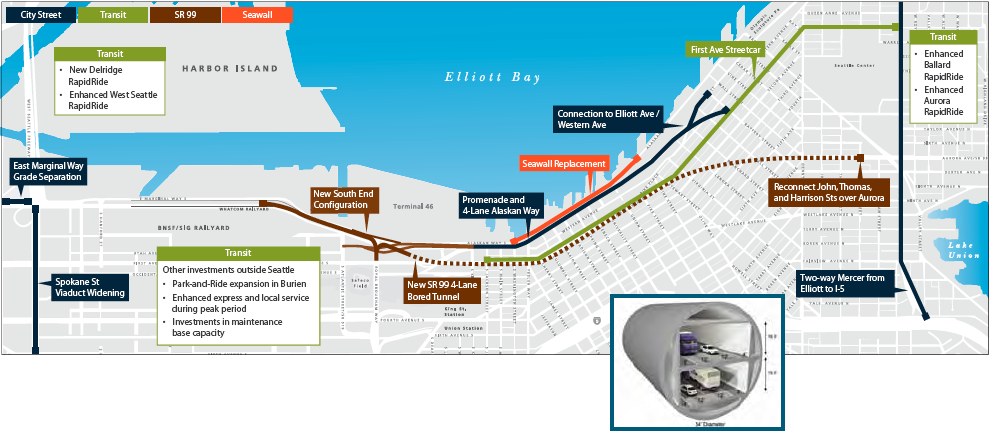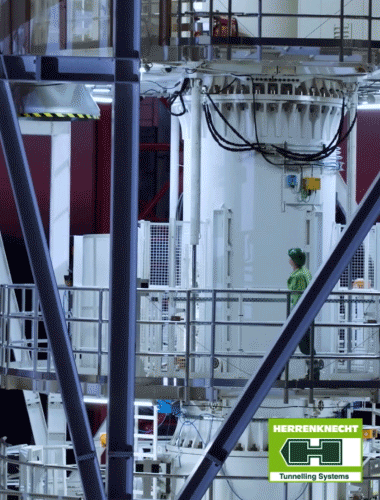DISCUSSION FORUM
Seattle's bored tunnel - a story of politics
Aug 2011
SPECIAL REPORT by Mike Lindblom
-
It was 10 years ago that the Nisqually earthquake undermined the Alaskan Way viaduct in Seattle. Since then there have been many twists and turns that led this week to a US Federal Government 'record of decision' to progress a bored tunnel replacement of the damaged infrastructure. Guest contributor Mike Lindblom, transportation writer at The Seattle Times, reflects on the 10 years of political wrangling that gave birth to an urban tunneling project of world-class credentials.
- On the morning of February 28, 2001, a magnitude 6.8 earthquake rattled Seattle for 45 seconds, causing political aftershocks that linger today.
- The swaying damaged the old Alaskan Way Viaduct, a six-lane double-decked stretch of Highway 99 built on loose waterfront fill soil, where four support columns began to sink as a result. People thought of the I-880 double-decked bridge in Oakland, California, that pancaked and killed 42 motorists in an earthquake in 1989 - and about traffic jams. The next day, while the viaduct was closed for inspection, an ambulance carrying my father took two hours to go from West Seattle to a hospital two blocks east of downtown.
The quake-damaged viaduct, closed for repair in 2001 (left) and with braces strengthening the support columns (centre), is to be replaced with a bored tunnel under the highrise CBD
- After a decade of debate, and a chaotic citizen advisory vote in 2007 over how to replace the viaduct, the Washington State Department of Transportation (WSDOT) has selected to bore a record 57.4ft diameter tunnel through Seattle's abrasive soils. A $1.4 billion contract has been signed with Spanish tunneling firm Dragados and California-based Tutor-Perini and the Federal Government signed the environmental-impact statement for its construction this week (Tuesday, 23 August, 2011).
- This follows a citizens' ballot that closed on 16 August for a second advisory measure. Referendum 1 was set to either approve or reject the process by which Seattle City Council enacts its agreements with WSDOT for issues concerning diversion of utilities, public liability, design review, and street use in particular reference to the proposed replacement tunnel project.
- But why the belated vote? And could opponents really stop the project?
- Seattle's natural setting, on an isthmus between the Salish Sea and Lake Washington, offers both splendid vistas and spectacular costs for rail-transit and highway infrastructure. A tradition of populism-trained voters, who bring high levels of formal education and book-reading to debates, expected to have their say.
- The fundamental challenge is that none of the options on offer enjoys majority support. The options included the financially risky tunnel; a new elevated road that clutters the shore; a surface boulevard that makes driving slower; and a seismic retrofit of the old existing viaduct.
- Councilman Nick Licata calls a tunnel the worst possible answer - except for all the others.
- Meanwhile, tunnel-boring machine technology has evolved to the point were one giant-sized tube can carry four highway lanes. It would cost less than an earlier cut-and-cover strategy that WSDOT abandoned. State Governor Chris Gregoire initially leaned toward an elevated route but suddenly backed a bored tunnel in January 2009, after nine weeks of financial calculations carried out by senior WSDOT engineers and tunnel industry experts Harvey Parker and John Reilly.
- Opponents called it a 'backroom deal' when relieved legislators quickly earmarked $2.4 billion in gas tax and federal grants to the tunnel option. Another $400 million from tolls and $300 million in port-district property tax would fill the estimated $3.1 budget for the tunnel plus interchanges at either end.
- The leading tunnel opponent is Mayor of Seattle Mike McGinn, an ex-Sierra Club chairman who regularly commutes to work on his bicycle. In his 2009 campaign, McGinn agreed with findings that 50,000 of the 110,000 daily car trips on Highway 99, of which the viaduct is part, must vanish for his green alternative of using transit, arterials, and a widened Interstate 5 highway alternative to succeed. "Automobiles are like in-laws. You want to have good relations with them, but you don't want them to run your lives," he said.
-

Alignment of the bored tunnel replacement under the city
- McGinn declared later he would not be obstructionist, but blasted away at the cost risks as Mayor. Thom Neff, a mega-project expert consulting for McGinn, called the Highway 99 job "beyond precedent". Skeptics could look only a few miles away, to the Brightwater sewer project where a TBM was stuck, and to the Beacon Hill transit tunnel where voids opened due to errors in measuring TBM soil excavation rates. Either mistake would be more dire beneath skyscrapers downtown, it was argued.
- A Referendum 1 (R-1) vote reached the ballot after a petition drive led by the Sierra Club and the Real Change homeless newspaper exceeded the necessary 21,000 signatures, and an ambivalent local judge chose to preserve the voters’ only chance to have their say on the bored tunnel proposal. Another faction, Seattle Citizens Against the Tunnel (SCAT) helped with the R-1 campaign. SCAT’s own ballot measure, Initiative 101 in favor of a new or fixed viaduct, was quashed in court on grounds that the City cannot bar a State project.
-
What happened next?
The pro-tunnel, anti-dithering camps won the day last week with 58% supporting the measure and delivering a mandate for a Second Official Notice to Proceed, and a groundbreaking start in September. Opponents could now sue by arguing WSDOT flouted the environmental-impact process by signing a procurement contract before the impacts were fully reviewed. But appeals judges tend to defer to government agencies. - Had the vote been only narrowly in favor the project, council members could have replied that there was no clear voter message. They could then re-enact the City-WSDOT agreements by ordinance, then override a McGinn veto, in a few weeks.
-

The ballot paper wording
- Things get more interesting, had the 'rejected' vote won by a landslide. Anti-tunnel activists would then have tried to peel off weaker members of the Council's 8-1 pro-tunnel majority, and then storm the Legislature. "When the people speak, elected officials have to listen", argued anti-tunnel Councilman Mike O'Brien.
- Legislators however displayed no interest in revisiting the issue. When they convene in 2012, excavation at the south tunnel portal could well be under way.
- If they had balked at the tunnel, lawmakers predicted an attempt to shift the State's $2.4 billion contribution to the project in Seattle toward other parts of the State.
- "Why would my colleagues from outside Seattle in the Legislature step back into a Seattle food fight, during the worst economic crisis of my lifetime?" state Senator Ed Murray Democrat, Seattle, told the Seattle Times. "I think legislators are more concerned with finding money for other causes, including higher education and human services."
- But there was a reason that Dragados, Tutor-Perini and HNTB, the contracted builders of the tunnel, dropped $60,000 into the Let's Move Forward pro-tunnel campaign. Seattle has a record of fighting and defeating mega-projects. Highway critics point back to the 1970s when sustained resistance killed an east-west expressway through Seattle neighborhoods. In 2007 the Sierra Club defied the establishment to help trounce a regional highways-and-transit measure. The regional transit agency returned with a rail-only version and prevailed, riding the coat-tails of the new Barack Obama Administration in Washington DC.
- But it would be harder to persuade cranky lawmakers to cancel a signed contract, eat more than $175 million spent on tunnel design to date, and, above all, launch a divisive new planning cycle. The ballot result last week avoided the need by ending the political wrangling of a decade and giving the bored tunnel project a green light to progress.
- (Mike Lindblom, The Seattle Times, mlindblom@seattletimes.com; +1 206-515-5631)
- Statements for and against Referendum 1 question on the ballot paper
- The statement for approval
- Enough is enough. We all know the Alaskan Way Viaduct is dangerous and needs to be replaced.
- For ten years we've studied every conceivable option. As representatives of Pike Place Market, neighborhood businesses, and working families we participated in many of these discussions, and we were happy to reach concensus with transportation engineers, citizen advisory panels, the Seattle City Council, King County Executive and Governor to move people and freight with a tunnel. Construction contracts have been awarded and work has begun – ahead of schedule and under budget. Why are we second-guessing this now?
- The tunnel is the only option with funding from the state and the only option that keeps the Viaduct open during construction.
- We've talked about replacing the Viaduct longer than it took to fight World War II. Mayor Mike McGinn and other Ref 1 opponents use delay and obstruction to push their own agenda, which is to replace the Viaduct with nothing and force 110,000 cars on the city streets and I-5, with no state money for transit or road improvements. What does this "surface option" mean for you? More traffic, more delay, buses and freight caught in gridlock.
-
The statement against
Referendum 1 is your opportunity to tell the politicians to reject a tolled deep-bore tunnel replacement of the Alaskan Way Viaduct.
In 2009 politicians cut a risky and expensive backroom deal to pursue a tolled tunnel under Seattle. In an economic downturn they chose a Viaduct replacement option with no exits downtown and a price tag of one billion dollars more than other solutions. Since then they have refused to have a transparent conversation about the project or explain how they will address the project’s practical and financial failures.
The facts about the tolled tunnel are clear – it will:
• Result in significant tax increases to cover the $700 million project funding defecit
• Stick Seattle taxpayers with the bill for cost overruns
• Increase congestion with $7-$9 roundtrip tolls forcing tens of thousands of cars onto city streets, and
• Make transit service worse
The tolled tunnel is a terrible idea that does not align with our priorities. We can't afford it and it puts the future of our city at risk.
-
Federal approval for Seattle's bored tunnel - TunnelTalk, August 2011
Voters back the bored tunnel in Seattle - TunnelTalk, August 2011
Japanese machine for Alaskan Way mega drive - TunnelTalk, July 2011
Alaskan Way bored tunnel alignment – video report - TunnelCast, Oct 2010
Alaskan Way contract signed - TunnelTalk, Jan 2011
Alaskan Way frustration - TunnelTalk, Sep 2007
Brightwater excavation complete - TunnelTalk, August 2011
Beacon Hill void investigation - TunnelTalk, July 2009
|
|
|
|
|
Add your comment
- Thank you for taking the time to share your thoughts and comments. You share in the wider tunnelling community, so please keep your comments smart and civil. Don't attack other readers personally, and keep your language professional.




